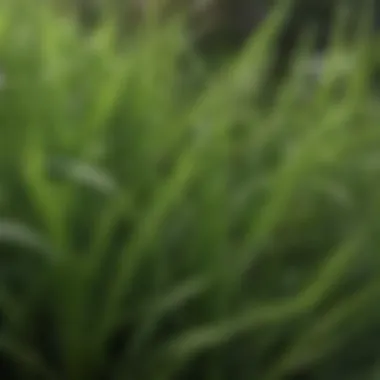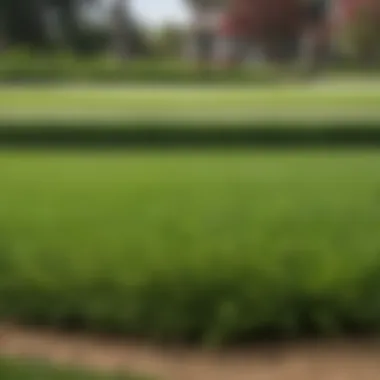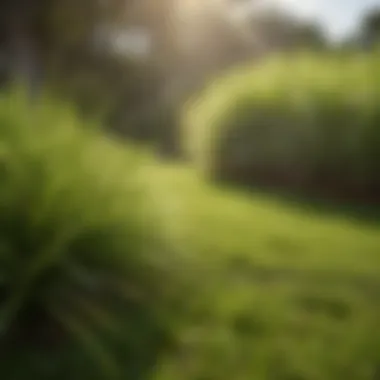Discovering Top Zoysia Grass Varieties for Healthy Lawns


Intro
Zoysia grass is a popular choice for lawns due to its unique characteristics and resilience. This article serves as a comprehensive guide to various zoysia grass varieties, focusing on what makes each one special. Homeowners and landscaping professionals alike will benefit from a deeper understanding of the complexities of zoysia grass, from growth habits to pest resistance.
By discussing attributes like climate adaptability and maintenance needs, readers can choose the best zoysia grass for their specific environments. In dught, finding the right zoysia variety not only enhances lawn aesthetics but also supports overall ecological health. Lets explore together this fascinating topic.
Types of Zoysia Grass
Zoysia japonica
This variety, commonly known as Japanese zoysia, has a broad blade structure and dense growth. It thrives in a range of climates, from temperate to tropical. The deep roots provide excellent drought resistance. When properly maintained, colonisactions can become lush and green.
Zoysia matrella
Matrella is recognized for its fine blades and dense morphology. It grows primarily in warmer climates. The grass texture is plush, making it pleasant for feet. Thanks to its robustness, it withstands wear well, making it a favorite in heavy-use areas.
Zoysia tenuifolia
This variety has narrow blades and lush appearance. Ideal for subtropical regions, it possesses high heat tolerance. However, its growth habit is slower compared to other zoysia types, requiring patience during establishment.
Growth Preferences
Zoysia grass varieties require full sunlight for optimal growth. However, some offer decent performance in partial shade. They generally prefer well-drained soils but adapt to various soil types.
For best results, when planting zoysia, ensure soil is prepared properly. Fertilization and irrigation are crucial in the initial growing period, ensuring robust establishment.
Maintenance Requirements
Zoysia grass is less demanding in maintenance compared to other lawn types. Here are some notable maintenance needs:
- Mowing: Regular mowing promotes healthy growth. Ideal height varies by species; typically around one to two inches is recommend.
- Fertilization: Fertilizing zoysia grass once in the spring and once in mid-summer offers nurturing nutrients.
- Irrigation: Limit watering after establishment as certain zoysia adaptations ensure drought resilience.
Pest Resistance
Zoysia grass has certain innate pest resistances, particularly against chinch bugs and grubs. However, other potential pests need monitoring. When discovered, early intervention with eco-friendly pesticides can manage infestations.
End
Choosing the right zoysia grass variety and maintaining it effectively promises success in achieving optimal lawn health. Using this article as a foundation, informed decisions can lead to compelling lawn landscapes. Understanding how each grapg species interacts with its environment enhances long-term satisfaction for homeowners and landscaping professionals. For other rich resources, you can visit Wikipedia, Britannica.
Preface to Zoysia Grass
Zoysia grass has become a popular choice for homeowners looking to create a lush and resilient lawn. Its tolerance to various climatic conditions and low maintenance requirements are some key benefits that enhance its desirability. This section lays the groundwork for understanding zoysia grass by defining it and tracing its origins.
Definition and Overview
Zoysia grass is a warm-season turfgrass known for its dense and attractive appearance. It thrives in warmer regions, typically in U.S. Department of Agriculture plant hardiness zones 6 to 9. As a fibrous-rooted grass, it establishes well in various soil types, making it versatile for different lawns. Its ability to adapt to varying conditions contributes significantly to its presence in many residential and commercial landscapes.
This grass variety forms a thick mat offering significant resistance to weeds. Unlike many other grass types, zoysia can grow both in full sun and partial shade, though it prefer sunny locations for optimal growth. Melding durability and aesthetics, zoysia is also relatively resistant to foot traffic, which is fit for areas that see regular activity.
History and Origin of Zoysia Grass
Zoysia grass originated from Southeast Asia, particularly in regions such as Japan, Korea, and China. It is named after the German botanist Karl von Zoys who studied this grass species. Zoysia grass has long been used in these areas due to its resilience and ability to withstand infrequent rainfall.
In the mid-20th century, zoysia was introduced to the United States, gaining recognition rapidly, both in residential areas and sports fields. Homeowners appreciated its ability to establish a -> durable lawn with low water and maintenance needs. Today, several cultivars exist, and ongoing research continues to uncover its potential to thrive in various growing conditions.
The appeal lies not only in its hardiness but also in its environmentally friendly nature. Zoysia grass helps in reducing runoff, capturing atmospheric carbon, and even requires less fertilizer due to its slow growth. Understanding the background of zoysia grass paves the way for evaluating which types may best fit specific lawns. Overall, zoysia grass represents an interesting blend of history and functionality degree."
Common Types of Zoysia Grass


Understanding the common types of zoysia grass is foundational for any homeowner or landscaping professional looking to create a vibrant lawn. Each variety boasts distinct traits suited for various environments, permitting greater adaptability across different climates and soil types. These specific zoysia varieties have evolved under unique conditions, which makes them excellent choices tailored for individual needs. The primary objective of this section is to review notable types of zoysia grass in terms of growth performance, ease of maintenance, and potential impact on overall lawn health.
Meyer Zoysia
Meyer zoysia is well-known for its resilience and adaptability. This variety thrives in regions across the United States, boasting strong drought resistance and ideal conditions for lawns. What sets Meyer zoysia apart is its dense growth habit, reducing opportunities for weeds to take hold. This grass retains a attractive green color throughout the growing season, even during periods of stress. Homeowners appreciate its moderate growth rate; however, it may require regular mowing to maintain its neat appearance.
Emerald Zoysia
Emerald zoysia is characterized by its fine texture and rich color, making it especially suitable for residential lawns and golf courses. This variety grows well both in warmer and transition zones, featuring excellent cold tolerance as compared to others. Another notable aspect of Emerald zoysia is its strong pest resistance, which can significantly reduce the need for chemical treatments. Proper maintenance with regular fertilization and mowing can enhance the lushness of this type of zoysia grass.
Zenith Zoysia
Zenith zoysia offers several advantageous traits, particularly its accelerated growth during the warmer months. With a growth habit that allows it to spread quickly and establish itself, it is particularly forgiving in terms of heat. Zenith adapts well in diverse soils and conditions, where moisture retention becomes essential. However, it requires a bit more diligent care compared to its counterparts, particularly when it comes to irrigation and fertilization practices; the proper methods can yield an extremely plush lawn.
Compadre Zoysia
Compadre zoysia presents a newer entry among zoysia types, recognized for its adaptability in moderate climates. This grass features a medium blade and demonstrates decent growth while being less requiring water than other types. The tight and extra robust genetic backbone grants it an edge in wear tolerance making it ideal for high-traffic areas like lawns intended for play or gatherings. Homeowners who select Compadre zoysia might see a longer transition phase while planted, but patience can lead to dense coverage and healthy growth over time.
While these zoysia grass variations each possess specific strengths and weaknesses, their distinctions provide frameworks to consider for selecting the right one that fits lawn care objectives and landscapes. Determining which type to choose will benefit significantly from understanding these critical characteristics.
Criteria for Selecting the Best Zoysia Grass
Choosing the right zoysia grass type has a direct impact on attaining lush, healthy lawns. The decision is influenced by various criteria, each carrying width and depth of bearing implications for selection rationale. Understanding them enhances the compatibility of zoysia grass with distinct lawn environments.
Climate Considerations
The climate profoundly shapes the growth and health of zoysia grass. Regions with warm summers and mild winters tend to favor zoysia due to its preference for heat.
- Warm Temperatures: Zoysia thrives in temperatures around 80°F. Areas with prolonged cold might see a decline in health.
- Humidity Levels: Optimal moisture in the air encourages prosperous growth. Excessive humidity, however, may invite pests.
Moreover, acclimatization to local temperature fluctuations ensures resilience. A variety such as Meyer boasts substantial heat tolerance, proving reliable for warmer climates. Packaging your selection based on geographical climatic nuances can drastically elevate lawn vitality.
Soil Type and Quality
Soil is foundational for every plant, including zoysia grass. It influences water retention, nutrient supply, and root establishment, critical for overall growth performance.
- Well-Drained Soil: Zoysia favors sandy loam. It provides efficient drainage, relieving concerns about root rot.
- pH Levels: The acidic to neutral range of 6 to 7 pH is optimal for nutrient availability. Testing soils before planting helps in timely amendments.
Poor soil quality can lead to weakened grass and increased susceptibility to pests and diseases. Therefore, knowing your soil type becomes essential for healthy zoysia growth.
Sunlight Requirements
Sunlight is a key element in lawn health. Zoysia does well in full sun although it shows capability to withstand partial shade. A significant insight is:[
Zoysia generally thrives in 6+ hours of direct sunlight daily.
- Sunlight Exposure: Varieties such as Emerald suitable for areas subject to full sunlight relay stronger establishment and growth.
- Shade Tolerance: However, there are types like Zenith that cope oppaptly with scattered sunlight.
Understanding precise sunlight adherence directely accelerates vigorous and uniform grass establishment.
Maintenance Level
Maintenance practices dictate the upkeep success of zoysia grass. Each variation possesses unique maintenance conduits. Homeowners should adopt necessary practices to support thriving lawns.
- Watering Regimen: Zoysia is drought tolerant but benefits from regular watering until established.
- Fertilization Chimera: Regularly apply a fertilization mixture rich in nitrogen during the growing months while observing the attributions of soil testing.
- Mowing Frequency: Allowing the grass to grow can promote depth. Generally, aiming between one to two inches facilitates healthy routine manicuring.
A structured maintenance approach approaches and sustains optimum appearance through health optimization. It contextualizes your pivot towards specific grass types that might align with time and resources available.
Growth Habit and Performance


Understanding Growth Habit and Performance is crucial regarding Zoysia grass. This section analyzes the growth pace, adaptability during drought, and resistance against extreme climate conditions. Homeowners and landscaping professionals must consider these elements to achieve an entirely healthy lawn.
Growth Rate Analysis
Growth rate significantly affects how quickly a lawn can achieve aesthetic appeal and functional viability. Zoysia grasses typically exhibit slow initial growth, lagging in the early establishment phase compared to other grass types. However, once firmly rooted, Zoysia demonstrates a robust growth rate. Meyer Zoysia leads in fast establishment, best suited in warmer areas.*
Factors including soil quality, watering, and sunlight impact growth rate. In environments with fertile soil and full sun, Zoysia can spread rapidly through both underground rhizomes and above-ground stolons. Despite potently contributing to density, patience is often needed as typical growth patterns vary.
A proper understanding of Zoysia growth rates enhances decisions on lawn management.
Drought Resistance Capabilities
Zoysia grass is notably resilient, showcasing superior drought resistance. Its deep root structure enables it to access water from deeper soil layers. Even during extended dry periods, Zoysia may remain green while other types, like Kentucky bluegrass, succumb to drought stress. Choosing a drought-resistant variety honors both moisture conservation and minimal resource expenditure during arid seasons.
Such resilience also simplifies maintenance. Less frequent irrigation is necessary, thus reducing labor and water costs. Properly established Zoysia typically desires only about 1 inch of water per week, a manageable requirement even during short droughts. Notably, droughty conditions can trigger dormancy; the grace period allows Kansas City Zoysia to halt growth but flourish again once rainfall resumes.
Heat and Cold Tolerance
The adaptability of Zoysia grass deals directly with its performance across various climatic conditions. On the whole, most Zoysia varieties demonstrate robust heat tolerance, managing extreme summer temperatures due to their extensive root system and ability to thrive in warm climates. Meyer Zoysia particularly exemplifies such resistance.
However, Zoysia also stands out for its cold tolerance compared to others in its grass family. Mainly during colder months, types like Gulfstream can endure chilly winters. These features make Zoysia grass an expansive choice adaptable to widespread geographical zones, showing effectiveness in both temperate and tropical climates. As climate variations become more pronounced, selecting Zoysia for its growth habits can position homeowners favorably against unpredictable weather.
Strengthening Yto residential grassy aesthetics while sustaining overall lawn health reflects shared responsibilities for plant custodians. Through reliable growth rates, drought combativeness, and varied thermal acceptance, choosing the correct Zoysia variety lies well within informed decision-making.
Maintenance and Care for Zoysia Grass
Maintaining zoysia grass requires a thoughtful approach. It is important to manage the lawn so it thrives in its specific growing conditions. Good maintenance practices ensure the health and resilience of the grass over time. Furthermore, this facilitates a lush landscape that can be enjoyed by both people and pets. Understanding key management techniques is essential for homeowners and landscaping professionals alike.
Watering Strategies
Watering zoysia grass is a vital part of its care. Zoysia can thrive with moderate water levels. However, it should not be in soggy soil, which might damage its root system. A schedule to keep moisture balanced is a good approach. Here are some elements to make watering strategies effective:
- Frequency: Watering once a week is generally adequate, providing about an inch of water.
- Timing: Early mornings are the ideal time for watering. This reduces evaporation and encourages deep root growth.
- Signs of Need: Monitor for signs like color changes or footprints remaining visible on the grass, indicating the lawn could use more water.
Fertilization Guidelines
Fertilizing provides the nutrients zoysia grass needs. It supports healthy growth and vibrancy. Here are core guidelines:
- Types of Fertilizer: Both granular and liquid fertilizers can work well. Choose one with a balanced N-P-K ratio, suited specifically for lawns.
- Application Timing: Fertilization is best done in spring when growth begins. A second application in late summer can also bebeneficial.
- Soil Testing: Conducting a soil test before fertilizing helps to understand what nutrients are actually needed.
Mowing Practices
Proper mowing is crucial in sustaining the health of zoysia grass. It encourages robust growth and prevents weed infiltration. Here are some practices to follow:
- Height of Cut: Mowing to a height of 1 to 2 inches supports denser growth. Avoid cutting too short as it can hamper growth.
- Mower Health: Ensure that the mower blades are sharp. Dull blades can cause ragged cuts and stress the lawn.
- Schedule: Mow regularly during the growing season. Weekly is recommended, but during peak growth, adjust as necessary to maintain a healthy lawn.
Following these guidelines for maintaining zoysia grass improves lawn health drastically. Regular observation and ajustment can lead to a flourishing green carpet.
Common Pests and Diseases Affecting Zoysia Grass
Understanding common pests and diseases affecting Zoysia grass is essential for maintaining a perfect lawn. Zoysia grass is known for its hardiness and endurance, but it is still susceptible to threats that can diminish its aesthetic and health. Evaluating potential threats is critical for anyone who wants to ensure the longevity and wellness of their grass. Knowledge of how to identify these issues along with implementing effective management strategies can help achieve a resilient lawn environment.
Identifying Common Pests
Pests can be a significant stressor for Zoysia grass. Some common pests include:
- Grubs: These are larvae primarily from beetles. They feed on the roots of the grass, causing signs of wilting, browning, and thinning.
- Chinch Bugs: These insects are small but can ravage large areas quickly. Their presence is often indicated by yellow patches or dead spots on the lawn.
- Billbugs: Adult billbugs can damage the grass by feeding on the stems and roots. Check for “stone-like” structures near the base of your grass blades, indicating their presence.
Observe how quickly these pests appear. The early detection may prevent extensive damage. Monitor your lawn regularly, especially during the growing season, and approach strategies to manage any infestations.


Diseases and Treatment Options
Zoysia grass can also fall prey to various diseases that come from environmental conditions or pests. Notable diseases that should be recognized include:
- Brown Patch: Caused by a moisture-rich environment, this disease presents as circular brownish patches. It's more common in warm, humid conditions and typically requires improved drainage and air circulation to treat.
- Zoysia Patch (yellow patch): This fungus creates patches that have a yellowish appearance on grass stems. Controlling it often involves changing cultural practices like reducing excessive water and maintaining optimal soil pH.
- Dollar Spot: Appearing as small, water-soaked spots, dollar spot could potentially ruin an otherwise healthy lawn if left untreated. Regular mowing and adequate fertilization can help mitigate this disease.
When treated promptly, these diseases can often be controlled with the right action plan. Fungicides may be another route, although their use should be a last recourse. As preventative care is always best, maintaining good cultural practices goes a long way to protect Zoysia grass.
Proper lawn care, adaptation to current weather patterns, and an understanding of pests and diseases greatly enhance Zoysia’s resilience.
Comparative Analysis of Zoysia Grass Varieties
Understanding the distinguishing qualities of varying zoysia grass types is necessary for making informed decisions. This comparative analysis focuses on the unique strengths and weaknesses of each variety, which helps homeowners and landscape professionals see which may work best in their specific situations. Here are vital factors to consider when analyzing these grass types: climate adaptability, health, maintenance requirements, pest resistance, and aesthetic qualities.
Evaluating varying characteristics leads to a lush lawn while diminishing potential problems. When you compare varieties, it allows the gardener to foresee challenges, saving both time and effort in the long-term management of the lawn.
Strengths and Weaknesses of Each Type
When selecting zoysia grass, knowing the strengths and weaknesses of each variety is critical. Each species offers different advantages suited to unique environmental conditions and lawn care practices.
Meyer Zoysia
Strengths: Meyer Zoysia has a robust growth habit and is tolerant of various cooler climates. Its deep root system provides good drought resistance, making it an excellent option for low-maintenance lawns. Furthermore, it exhibits excellent wear tolerance, ideal for high-traffic areas.
Weaknesses: Its slower establishment in the early growing season can sometimes frustrate superior results during the first season. You then wait sometimes over a year for the lawn to achieve its optimal density.
Emerald Zoysia
Strengths: Widely recognized for its rich green color, Emerald Zoysia provide a beautiful and lush carpet that boosts aesthetic appeal. Its fine texture and density distinguish it from others and make it considerably durable against foot traffic.
Weaknesses: However, it requires more attention, particularly in management. Emerald Zoysia doesn't fare well under heavy shade and must receive a reasonable amount of sunlight to thrive, which can limit its placement in your yard.
Zenith Zoysia
Strengths: Zenith Zoysia is relatively fast-growing. It can quickly establish a lawn, often making it suitable for homeowners looking for faster coverage. It also tolerates more cold-resistant temperatures better than others, plus it shows good drought resistance as well.
Weaknesses: This variety remains less tolerant to soil compaction. Additionally, it requires regular mowing during the growing season to manage its relatively tall growth.
Compadre Zoysia
Strengths: Compadre Zoysia stands out due to its high versatility and adaptability. This variety’s maintenance routine is often simpler compared to counterparts; it can thrive in various soil types without arduous requirements being attached to forage management.
Weaknesses: Its heat tolerance doesn't measure up to that of other versions, making it less suitable for areas subjected to high temperatures.
A thorough evaluation of these strengths and weaknesses aids garden enthusiasts in realizing what variety aligns with their preferences and environments. Each zoysia type supports different needs, making this analysis a powerful resource. >
"Choosing the right zoysia grass is more than just aesthetics; it's a critical decision for the long-term health of your lawn."
The End
Understanding which zoysia grass variety is most suitable for your lawn can significantly impact its health and upkeep. This article highlights various aspects of zoysia grass types, their specific benefits, and how they adapt to different conditions. Correct selection can optimize the aesthetic quality and durability of your lawn, and help homeowners avoid costly mistakes.
Summarizing Key Points
In summary, several key elements emerge regarding zoysia grass varieties:
- Climate Compatibility: Zoysia grass thrives in warm climates but varies in tolerances. Knowing your local weather conditions aids in selecting the right type.
- Growth Traits: Among the discussed varieties, for instance, Meyer Zoysia has a fast growth rate, while Zenayth Zoysia presents a lower growth habit. This affects how often you must mow.
- Maintenance Needs: Regular watering and fertilization needs differ among varieties. Emerald Zoysia, for example, requires specific attention to prevent pests.
- Resilience: Varieties like Compadre have attributes that resist wear and can adapt to various foot traffic levels. Such features are critical for households with kids or pets.
Providing a comprehensive understanding of these elements facilitates the pathway for developing a rich and enduring lawn. Each choice calls for distinct care regimens to maintain its vigor and appearance over time.
Final Recommendations
When selecting a zoysia variety, practical recommendations are paramount:
- Assess your local soil pH and texture. Conduct a testing if necessary; some grasses flourish in sandy or loamy conditions better than others.
- Consider your commitment to lawn care. If maintenance is limited, choosing a drought-resistant variety might be worthwhile.
- Select based on household activity; if kids or pets utilize the yard, putting emphasis on wear-resistant varieties can preserve lushness.
- Lastly, it is essential to learn some basic pest control practices. Awareness can safeguard the selected grasses and save considerable frustration down the line.
With the right choice and diligent care, establishing a lush zoysia lawn opens avenues for numerous ecological benefits, such as improved air quality and enhanced wildlife habitats. Explore the benefits with patience to cultivate a satisfying and enjoyable outdoor space.







